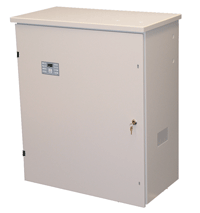|
|
Medical
eLITE Model ELN (550W to 1.5kW)
|
Description
Meeting the NFPA 101 and NFPA 111 standards, the "ELN" is considered "Life Safety Equipment". The "ELN" is also UL 924 listed, providing the required 90 minutes of emergency backup power, and is 100% compatible with all lighting applications and building security systems. This unit provides uninterrupted, regulated, continuous sinewave output for use with "normally on" lighting fixtures and exit lamps, as well as standby output for use with "normally off" emergency lighting fixtures. It is also generator-compatible. With a front-access design and a small footprint, the "ELN" is suited for wall- or floor-mounted installations. Available in 550W to 1500W single phase sizes, the "ELN" is ideal for schools, athletic fields, shopping centers, parking structures, churches, restaurants, theaters, hotels, and many other similar applications.
Single Phase Sizes: 550W, 1kW, 1.5kW
Features & Benefits
Technical Specs
Applications
FAQ |
|
|
- Listed UL 924 Emergency Lighting Equipment and Auxiliary Power Supplies.
- Meets NFPA 101 and NFPA 111 standards, including SEPSS (Stored Electrical Energy Emergency and Standby Power Systems). Meets NEC and local codes.
- Uninterrupted, regulated, continuous sinewave output for use with "Normally On" lighting fixtures and exit lamps.
- Standby output for use with "Normally Off" lighting fixtures
- Programmable, timed "Normally Off" and "Normally On" outputs
- Integral constant voltage transformer isolates and regulates output voltage.
- Compatible with all lighting applications: HID, high-pressure sodium, fluorescent, incandescent, halogen, quartz, etc.
- System approved for 42k AIC rated source.
- Integral status and alarm panel.
- Front-access design and small footprint are ideal for wall- or floor-mounted installations.
- Remote communications via alarm signals or RS232.
- Remote status panel, and automatic phone dialer.
- Generator-compatible.
- NEMA 3R enclosure options for outdoor installations --- consult factory.
|
|
- Input Operating Voltage Range: +10%, -40% typical, load-dependent, without battery usage
- Input Frequency: 60 Hz, +/- 2.5%
- Output Sine Wave Voltage: Maximum 3% harmonic distortion, any single harmonic
- Power Factor: Self-correcting to >0.95
- Line Voltage Regulation: +/- 3%
- Load Regulation: Typically better than +/- 3%
- Isolation: Galvanic
- Standard Unit Operating Temperature: 0°C to +40°C
- Total System MTBF: 100,000 hours
- Common Mode Noise Rejection: 120 dB
- Transverse Mode Noise Rejection: 70 dB
- Efficiency: 89% typical
|
|
- Schools
- Gymnasiums / Athletic Fields
- Indoor / Outdoor Security Lighting
- Outdoor Egress
- Security Systems
- Parking Structures / Garages
- Hospitals / Clinics
- Shopping Centers / Strip Malls
- Banks / Financial Institutions
- Worship Facilities
- Restaurants
- Theaters
- Hotels / Motels
|
|
- What is a lighting inverter?
A lighting inverter is an electronic system that converts DC battery power to standard AC voltages to provide back-up for lighting systems. This inverter provides convenient power for many styles of lighting; increasing its usability.
- Why use centralized lighting inverters?
Centralized lighting inverters provide a single point source of power for all emergency lighting and exit signs. This offers simple maintenance and provides for a controlled, logical, wiring scheme. The output of the inverter is fed to a dedicated lighting panel, which provides only the power for the emergency lighting system.
- Is there a difference in lighting inverters?
YES! Lighting inverters differ in switch time, voltage regulation, and power conditioning. The standards for emergency lighting inverters are defined in the UL924 test procedures. These procedures omit the difference in characteristics. Some inverters may take up to 10 seconds to respond to a power outage, while others provide a seamless transfer. The seamless transfer systems provide the kind of power necessary for HID, lighting control, and alarm circuits.
- How important is the transfer time?
Transfer time is the time it takes to recognize and deliver emergency power. In some rare cases, this may not be an issue, but for most cases, it should be ZERO. Zero transfer time insures that there is no interruption of power; a very important factor with HID lighting systems such as high pressure sodium lighting. Lighting control systems and alarm circuits can also be powered by a no-break transfer inverter.
- Should lighting inverters include voltage regulation and power conditioning?
YES. Voltage regulation ensures that voltage drops and brownouts do not affect the overall lighting system. Voltage regulation also ensures proper lighting levels during normal operating conditions in "Normally On" circuits. Power conditioning prevents surges and transients from reaching the electronic ballasts, thus providing longer life of the lighting fixture.
- Do lighting inverters ensure constant illumination of high pressure sodium and other HID lighting fixtures?
Only those lighting inverters that deliver voltage regulation and no break transfer, such as the "eLITE" family of inverters, will protect these lighting systems. Losing 1/2 cycle causes HID lamps to extinguish, and they require up to 10 minutes to restart!
- Can any UPS (battery back-up) be used for emergency lighting?
NO. Emergency lighting systems are governed by UL924 standards. Only lighting inverters that have been tested and certified to this standard can be used.
|
|
|
|
|



